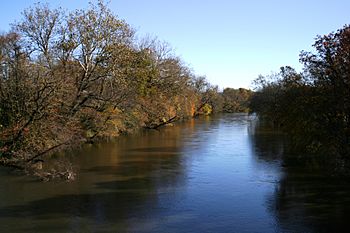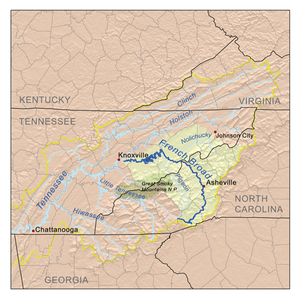French Broad River facts for kids
Quick facts for kids French Broad River |
|
|---|---|

French Broad River in Henderson County, North Carolina
|
|

French Broad River watershed
|
|
| Country | United States |
| State | North Carolina, Tennessee |
| Physical characteristics | |
| Main source | North Fork French Broad River Transylvania County, North Carolina 3,189 ft (972 m) 35°15′57″N 82°53′20″W / 35.26583°N 82.88889°W |
| 2nd source | West Fork French Broad River Transylvania County, North Carolina 3,440 ft (1,050 m) 35°11′09″N 82°59′01″W / 35.18583°N 82.98361°W |
| River mouth | Tennessee River Knoxville, Tennessee 814 ft (248 m) 35°57′33″N 83°51′0″W / 35.95917°N 83.85000°W |
| Length | 219 mi (352 km) |
| Basin features | |
| Progression | French Broad → Tennessee → Ohio → Mississippi |
| Basin size | 5,124 sq mi (13,270 km2) |
| Tributaries |
|
The French Broad River is a long river in the United States. It flows for about 218 miles (351 km) (351 km). The river starts near Rosman in Transylvania County, North Carolina. It then flows into the state of Tennessee.
The French Broad River joins with the Holston River in Knoxville. This meeting point is where the Tennessee River officially begins. The French Broad River passes through several counties in North Carolina and Tennessee. It also drains parts of the Pisgah National Forest and the Cherokee National Forest.
Contents
River's Journey
The French Broad River begins in Transylvania County, North Carolina. Its starting points are near the Eastern Continental Divide. One source is a 50-foot waterfall called Courthouse Falls. This waterfall feeds into a creek that becomes the North Fork. The North Fork then joins the West Fork. South of Rosman, the Middle and East forks also join, forming the main French Broad River.
Flow Through North Carolina
From its start, the river flows northeast through the Appalachian Mountains. It goes through Henderson and Buncombe counties. In Buncombe County, the river flows through the city of Asheville. Here, it meets the Swannanoa River.
After Asheville, the river continues north through Madison County. The town of Marshall grew up along the river. The river then passes through Hot Springs, a mountain resort. After this, it enters Cocke County, Tennessee.
Flow Through Tennessee
In Cocke County, Tennessee, the river flows past Del Rio. It is joined by the Pigeon and Nolichucky rivers. These rivers meet northwest of Newport.
The river then flows into Douglas Lake. This lake was made by the Tennessee Valley Authority (TVA) when they built Douglas Dam. The dam is in Sevier County. Near Sevierville, the French Broad River receives water from the Little Pigeon River. This river drains a large part of the Great Smoky Mountains.
Finally, the French Broad River enters Knox County. It meets the Holston River at a place called "Forks of the River." This is at the eastern edge of Knoxville. This meeting point is the official start of the Tennessee River.
Main Rivers Joining the French Broad
Many smaller rivers and creeks flow into the French Broad River. These are called tributaries. Some of the main ones include:
- North Fork
- West Fork
- East Fork
- Middle Fork
- Pigeon River
- Nolichucky River
- Mills River
- Davidson River
- Swannanoa River
- Little River (French Broad River)
River's Past
The French Broad River is thought to be one of the oldest rivers in the world. This is because it cuts through very old rocks in the Southern Appalachian Mountains. However, it is hard to know its exact age.
The Cherokee people were the first Native Americans to live in this area. They had different names for the river. They called it Poelico and Agiqua in the mountains. Upriver from Asheville, they called it Zillicoah. From Asheville downstream, they called it Tahkeeosteh, which means "racing waters." The river roughly marked the eastern edge of the Cherokee lands. The French explorers also called the river Agiqua, using one of the Cherokee names.
Douglas Dam
In the 1940s, the Tennessee Valley Authority (TVA) built Douglas Dam. This dam is on the lower part of the French Broad River. It was built to create electricity and help control floods. Douglas Dam is one of the biggest TVA projects on a river that flows into the Tennessee River.
French Broad River State Trail
In 1987, North Carolina created the French Broad River State Trail. This is a special water trail, also called a blueway. It follows the river for 117 miles (188 km) (188 km). The trail is part of the North Carolina State Trails System. There are many places along the river where people can launch their boats or kayaks to enjoy the trail.
Part of the French Broad River in Tennessee is also a state scenic river. This means it is protected for its natural beauty. About 33 miles (53 km) (53 km) of the river in Cocke County is a "Partially Developed River."
River Crossings
Many bridges cross the French Broad River. Here are some of the main crossings:
North Carolina Crossings
- Transylvania and Henderson Counties
- Patton Bridge
- McLean Bridge (U.S. 64) in Etowah
- Kings Bridge (N.C. 191)
- Boylston Highway (N.C. 280) near the Asheville Regional Airport
- Buncombe County/Asheville
- Blue Ridge Parkway
- Interstate 26
- Interstate 40 near the Biltmore Estate
- Bowen Bridge (Interstate 26/I-240/U.S. 19/U.S. 74) in Asheville
- Madison County
- Two Bridges connecting Marshall to Blannahasset Island
- Bridge in Hot Springs (U.S. 25/U.S. 70). The Appalachian Trail also crosses this bridge.
Tennessee Crossings
- Cocke County
- Wolf Creek Bridge
- James T Huff Bridge (U.S. 25/U.S. 70)
- U.S. 321 in Newport
- U.S. Route 25E (from Cocke County into Jefferson County)
- Douglas Lake to Knoxville
- Interstate 40 and Swann Bridge (U.S. 70) over Douglas Lake
- James D. Hoskins Bridge in Dandridge
- Douglas Dam Road
- TN 66 at Sevierville
See also
 In Spanish: Río French Broad para niños
In Spanish: Río French Broad para niños

